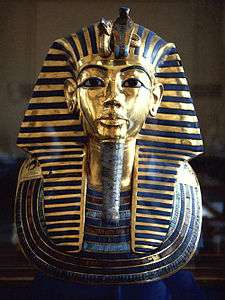Nemes
For other uses, see Nemes (disambiguation).

The golden mask from the mummy of Tutankhamun wearing the nemes headdress.
The nemes is the striped headcloth worn by pharaohs in ancient Egypt.[1] It covered the whole crown and back of the head and nape of the neck (sometimes also extending a little way down the back) and had lappets, two large flaps which hung down behind the ears and in front of both shoulders.[2] It was sometimes combined with the double crown,[3] as it is on the statues of Ramesses II at Abu Simbel. The earliest depiction of the nemes, along with a uraeus, is the ivory label of Den from the 1st Dynasty. It is not a crown in itself, but still symbolizes the pharaoh's power.
| ||||
| Nemes in hieroglyphs |
|---|
Gallery
- Statue from Abu Simbel, wearing the double crown, the uraeus, and the nemes.
_(Room_4).jpg) The Younger Memnon, wearing only the nemes and uraeus (the crown may have been lost)
The Younger Memnon, wearing only the nemes and uraeus (the crown may have been lost) The nemes in colour and in profile
The nemes in colour and in profile
Further reading
- Toby A. H. Wilkinson, Early Dynastic Egypt, Routledge 1999
- Bruce Graham Trigger, Ancient Egypt: A Social History, Cambridge University Press 1983
- Fragment of a basalt Egyptian-style statue of Ptolemy I
References
External links
 Media related to Nemes headcloth at Wikimedia Commons
Media related to Nemes headcloth at Wikimedia Commons
This article is issued from Wikipedia - version of the 8/16/2016. The text is available under the Creative Commons Attribution/Share Alike but additional terms may apply for the media files.